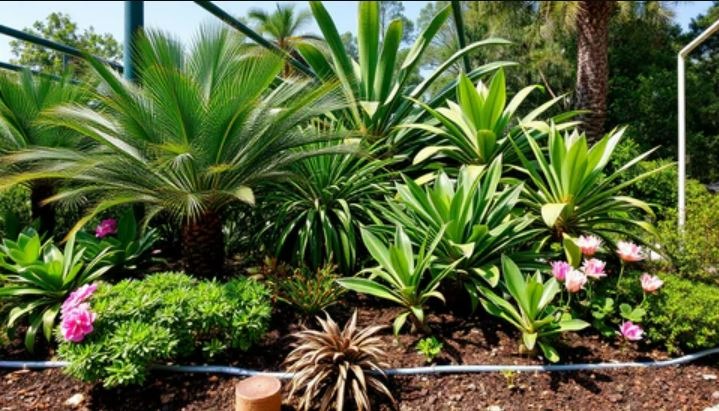CALL TODAY! → (407) 280-2364
The Importance of Choosing the Right Plants for Florida’s Climate
Discover how the right plant selection can save you time, water, and money while keeping your garden vibrant year-round. Learn which plants thrive best in Florida’s heat and humidity.
3/20/20254 min read


Understanding Florida’s Unique Climate
Florida is renowned for its diverse climate, which is characterized by high humidity levels, varying seasonal conditions, and notable temperature fluctuations. The state primarily experiences a subtropical and tropical climate, making it essential for gardeners to comprehend these unique environmental factors when selecting plants for successful cultivation. High humidity, especially prevalent during the summer months, can significantly influence the type of plants that thrive in the region. Plants that are tolerant to heat and moisture are generally recommended, as they can withstand the challenges posed by Florida's climate.
Additionally, Florida's distinct seasonal variations can create challenges for plant growth. The state experiences a wet season from May through October, which is often marked by heavy rainfall and thunderstorms. This can lead to potential issues such as soil erosion and root rot if the right plant selections are not made. Conversely, the dry season from November to April can bring periods of drought, necessitating plants that have drought-resistant qualities for sustainability. Understanding these natural rhythms enables gardeners to choose plants that will withstand stress and promote healthy growth.
Temperature fluctuations in Florida can also impact plant health significantly. While regions may experience mild winters, there are areas that encounter occasional frost or freeze events. Therefore, selecting frost-tolerant cultivars can be crucial for ensuring the survival of certain plants. Moreover, due to the geographical diversity of the state, microclimates can exist that further complicate plant selection. For example, coastal areas may offer different growing conditions compared to inland regions. Overall, knowledge of Florida's unique climate conditions is essential, as it lays the foundation for making informed decisions when it comes to selecting the appropriate plants for a thriving garden.
Native vs. Adaptive vs. Exotic Plants
Choosing the right plants for Florida’s climate involves understanding the distinctions between native, adaptive, and exotic plants. Native plants are those species that naturally occur within Florida’s ecosystems. They have evolved over time to thrive in local soil conditions, rainfall patterns, and temperature fluctuations, making them ideal for Florida’s unique environment. These plants not only require less maintenance and water than other types but also support local wildlife, including pollinators and other beneficial species, thereby enhancing the local biodiversity.
Adaptive plants, on the other hand, are species that have been introduced to Florida from other regions but have proven their ability to thrive in the state's varied climates. While adaptive plants can complement a garden and offer aesthetic diversity, their selection should be made with caution. They often share similar growing conditions with native plants, allowing them to coexist without overwhelming the ecosystem. However, it is essential to ensure that these plants do not outcompete native species or disrupt the local ecological balance.
Exotic plants, while often visually appealing and marketed for their unique characteristics, can pose significant risks to Florida’s ecosystems. Some of these species can become invasive, spreading rapidly and overpowering native flora. Invasive exotic plants can lead to reduced biodiversity, as they may not provide the necessary support for local wildlife and can alter soil composition and nutrient availability. When considering planting options, it is vital to weigh the pros and cons of exotic plants, keeping in mind their potential environmental impact. By thoughtfully selecting native or adaptive plants, one can play an essential role in preserving Florida's natural heritage and maintaining ecological harmony.
Benefits of Choosing the Right Plants
Choosing plants that are well-suited to Florida's unique climate offers numerous benefits that contribute to sustainable gardening practices. One significant advantage is the reduction in water usage. Florida often experiences periods of drought, making it essential for residents to opt for drought-resistant plants. For instance, native species such as the Saw Palmetto and Florida Yew require less water than non-native varieties, allowing homeowners to maintain lush gardens while conserving valuable resources. This responsible choice not only minimizes water waste but also lowers the cost associated with irrigation during dry spells.
Another crucial benefit of selecting the right plants involves the improvement of soil health. Native plants typically possess robust root systems that help prevent soil erosion and promote nutrient cycling. For example, the deep roots of the Florida-Friendly Landscaping™ concept can enhance soil structure and increase its ability to retain moisture. Furthermore, these plants contribute organic matter to the soil as they die back, enriching the ecosystem and fostering a thriving microbial community. This overall enhancement of soil health is vital for maintaining a resilient landscape that can withstand the challenges posed by Florida’s climate.
Moreover, many native plants exhibit significant pest resistance, which can dramatically reduce the need for chemical pesticides. By focusing on plants that naturally deter pests, such as the Firebush or the Coral Honeysuckle, gardening efforts become more eco-friendly. This approach not only supports local wildlife and pollinators but also protects the environment from harmful chemical runoff. Various studies highlight that gardens populated with native plants often require less intervention, leading to healthier ecosystems that thrive without reliance on chemical treatments. Ultimately, making informed decisions about plant selection fosters a more sustainable gardening paradigm.
Plant Recommendations and Professional Guidance
Selecting the right plants for Florida's unique climate is essential for establishing a thriving garden. The state's warm temperatures and high humidity levels create conditions that can be both rewarding and challenging for gardeners. Therefore, it is crucial to choose species that are well-suited to these specific environmental factors. One excellent option for Florida gardens is the Florida native plants, which have adapted to the local climate over time, fostering resilience against pests and diseases. These plants often require less maintenance, conserving both water and resources.
Among the recommended native species are the beautiful Coontie (Zamia integrifolia), a hardy plant that can tolerate drought and heavy rain, and the Firebush (Hamelia patens), renowned for attracting hummingbirds and butterflies while thriving in full sun. Additionally, the Southern Magnolia (Magnolia grandiflora) offers stunning blooms and a luscious, evergreen canopy that provides shade during hot summer months.
For homeowners seeking visually appealing options with less upkeep, adaptive plants such as the Mexican Bird of Paradise (Caesalpinia mexicana) and Black Eyed Susan (Rudbeckia hirta) are perfect choices. These plants can withstand Florida's climate, while also adding vibrant colors and textures to outdoor spaces.
To navigate this diverse selection, it is beneficial to consult experts like Santy Landscaping LLC, who specialize in understanding the local horticultural landscape. Their professional guidance offers invaluable assistance in selecting plants that not only align with your personal vision but also promote sustainability and environmental responsibility. Collaborating with nursery specialists ensures long-lasting garden success, fostering eco-friendly approaches and long-term growth.
CONTACT US
CALL:
COPYRIGHT © 2025 SANTY LANDSCAPING LLC.
SUSCRIBE TO OUR NEWS LETTER
EMAIL:
HOURS:
Mon-Sun
7:00 AM – 5:00 PM
FOLLOW US ON SOCIAL MEDIA












